Calendar, fol. 1r
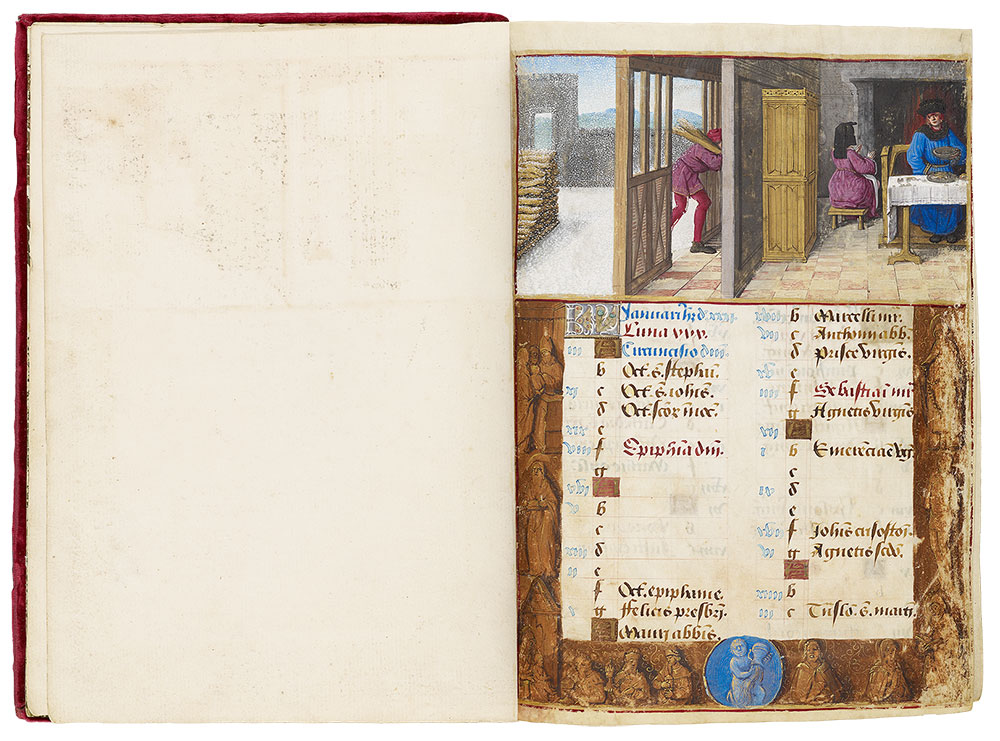
January: Feasting and Keeping Warm
Hours of Henry VIII
Illuminated by Jean Poyer
Gift of the Heineman Foundation, 1977
January: Feasting and Keeping Warm (fol. 1)
Calendars in Books of Hours do not demarcate time by enumerating the days from the first to the last of the month, as seen in this January page, but, rather list the important liturgical feasts of the month.
Inside, the lord of the house sits at his meal, his back to the hearth,as his wife, closer to the fire, warms her hands.
While a heavy snow covers the land, a laborer carries a few logs from the woodpile into the manor.
When Calendars in Horea (Latin for "Hours") were illustrated, they followed a tradition of depicting two vignettes in each month: the sign of the zodiac and the activity, usually agrarian, commonly undertaken during the season.
The borders illustrate some of January's major feasts, including, at top left, the Circumcision (feast on January 1). At bottom center is the zodiacal sign Aquarius, the Water Carrier.
MS H.8, fols. 1v–2r
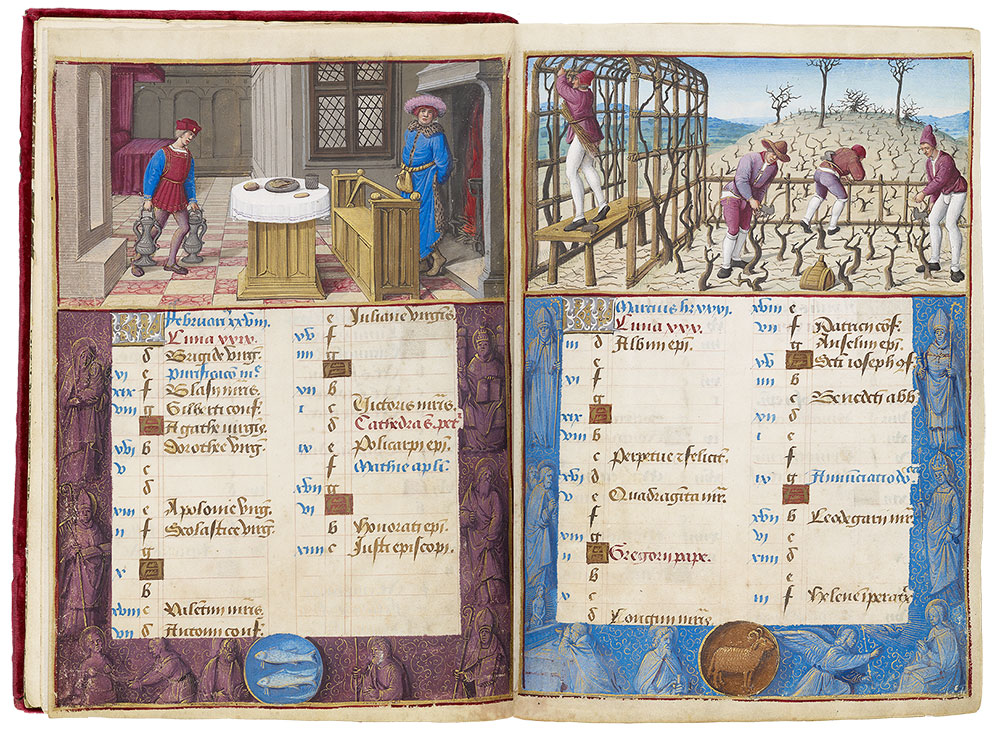
February: Keeping Warm
March: Pruning
Hours of Henry VIII
Illuminated by Jean Poyer
Gift of the Heineman Foundation, 1977
February: Keeping Warm (fol. 1v)
February's labor is not much different from January's. The lord of the house, richly dressed in fur-lined garments and hat, raises the folds of his clothes, to better warm his backside. His attention has been caught by his servant, who enters with flagons of wine.
In the left border are the Virgin holding the Christ Child (for the Feast of the Purification, February 2) and Sts. Blaise (holding his attribute, an iron comb, February 3), Agatha, whose breasts are being removed (February 5), and a generic male saint. The zodiacal sign is Pisces, the Fish.
March: Pruning (fol. 2)
In the early spring month of March, work begins outdoors with the typical labor of pruning the vineyard. Workers trim the leafless vines and tie them to the grape arbor. A wood cask for drink is in the foreground.
Among the scenes depicted in the margins are, at bottom left, St. Gregory with a vision at the altar of Christ (for the Feast of St. Gregory, March 12), and the Annunciation (March 25), at bottom right. Above the seated Virgin is St. Helena, discoverer of the True Cross, whose May 22 feast has been entered here mistakenly on March 31. The zodiacal sign is Aries, the Ram.
MS H.8, fols. 2v–3r
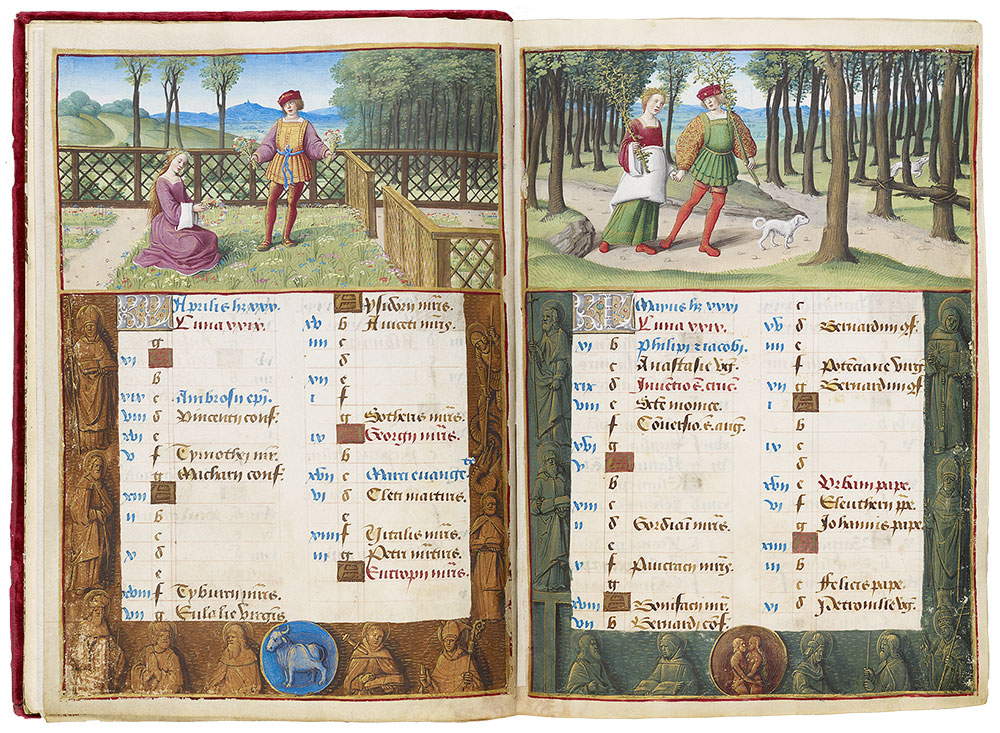
April: Picking Flowers and Making Wreaths
May: Picking Branches
Hours of Henry VIII
Illuminated by Jean Poyer
Gift of the Heineman Foundation, 1977
April: Picking Flowers and Making Wreaths (fol. 2v)
With April, the landscape becomes green and alive, and the month's activity is not laborious, but one for the leisure class. A foppishly dressed youth, his hands filled with freshly picked spring flowers, waits while his lady friend weaves the blossoms into a garland.
At the top of the right border is a depiction of St. George slaying the dragon (April 23). To the right of the zodiacal sign Taurus, the Bull, are Peter the Martyr, stabbed in the chest with a dagger, his attribute (April 29), and St. Eutropius, depicted with the ax with which he was struck in the head and killed (April 30).
May: Picking Branches (fol. 3)
Another leisurely couple partakes of May's pleasure, the gathering, on the first of the month, of flowering or leafing branches.
While one dog slowly leads the couple along a dirt path marked by branches tied across tree boughs, a second dog runs deeper into the woods on an uncharted track.
The rich border illustrations on the left side of May's calendar include images of Sts. Philip and James (May 1) and the True Cross (for the Feast of the Finding of the True Cross, May 3).
The zodiacal sign for Gemini portrays the Twins in naked embrace, possibly a visual reference to the couple depicted on the top half of the page.
MS H.8, fols. 3v–4r
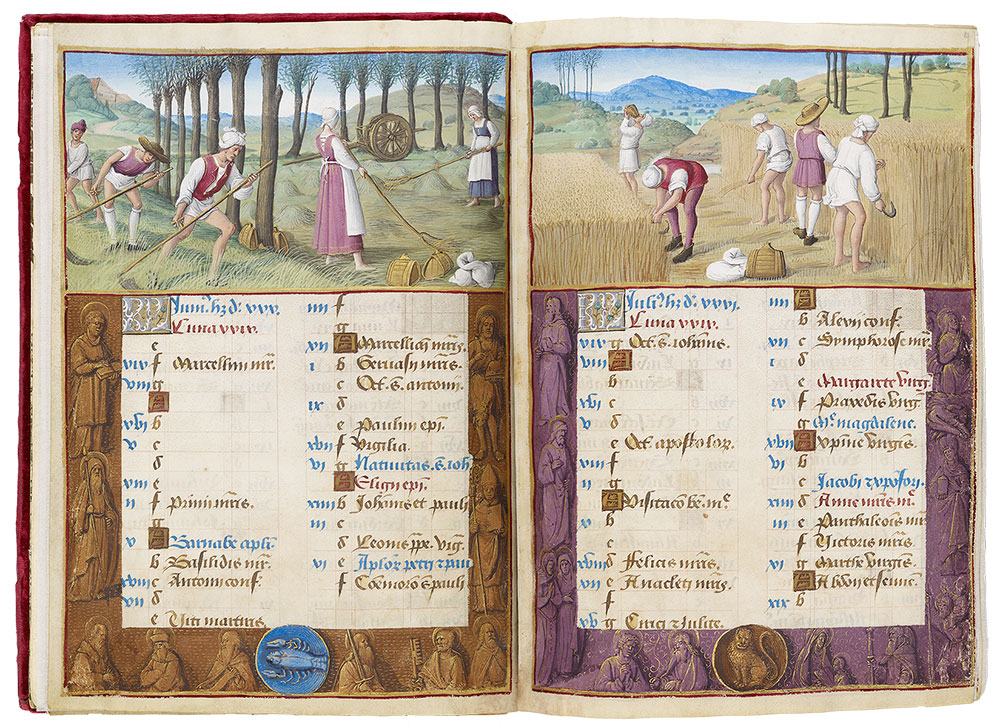
June: Mowing
July: Reaping
Hours of Henry VIII
Illuminated by Jean Poyer
Gift of the Heineman Foundation, 1977
June: Mowing (fol. 3v)
Summer's hard labors begin in June with the mowing of the hay.
Three men rhythmically attack the field with large scythes.
Two women rake the loose hay into stacks. Behind them, a wagon waits to be filled. In the foreground at the right are the workers' bundles of food and casks of drink.
On the right border are Sts. John the Baptist (feast of his Nativity on June 24), Eligius (June 25), a generic male saint, and Peter and Paul (June 29). The zodiacal sign is Cancer, the Crab.
July: Reaping (fol. 4)
The summer harvest continues in July with the reaping of the wheat. Four men, minimally dressed to keep cool, carefully cut the stalks with sickles and lay them in neat bundles. As in June, the foreground features, in the manner of a still life, their containers of food and drink.
Border: At the right are Sts. Margaret, shown emerging from the dragon (July 20), Mary Magdalene, holding her ointment jar (July 22), Christopher, carrying Christ on his back (feast on July 25, but indicated here on July 23), James, as a pilgrim (July 25), and Anne instructing the Virgin (July 26). The zodiacal sign is Leo, the Lion.
MS H.8, fols. 4v–5r
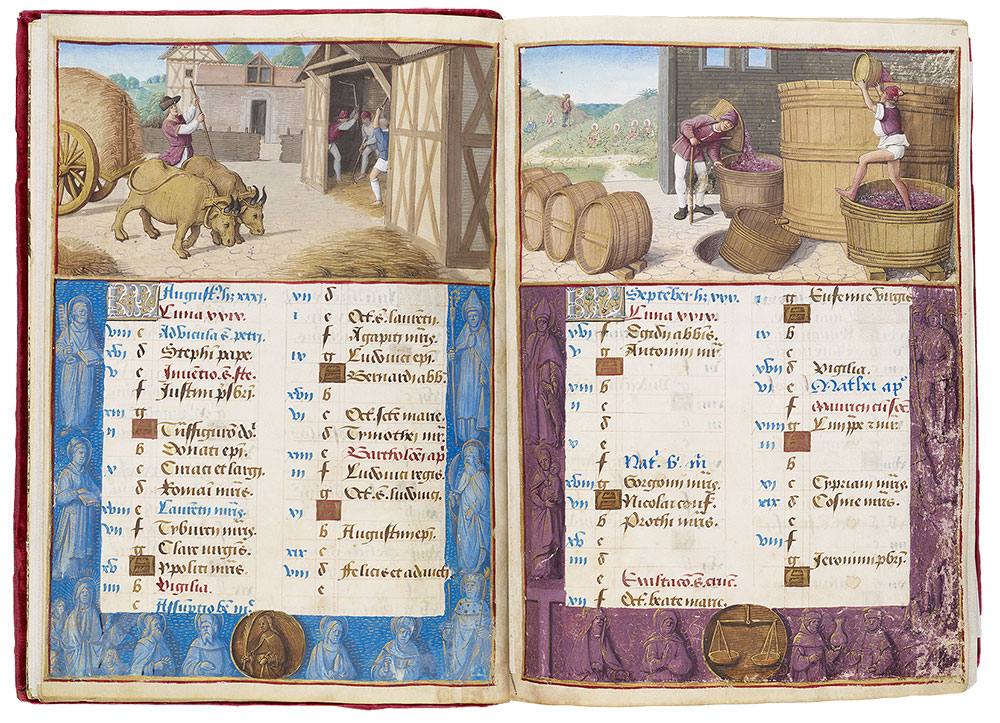
August: Threshing
September: Treading Grapes
Hours of Henry VIII
Illuminated by Jean Poyer
Gift of the Heineman Foundation, 1977
August: Threshing (fol. 4v)
The wheat harvest continues in August as the cut stalks are brought in oxcarts to the barn, where three men beat them with jointed flails.
Threshing with flails loosens the kernels of wheat from their stalks so that they can then be winnowed and thus separated from the chaff.
Starting at the top left margin is St. Peter (for the Feast of St. Peter in Chains, August 1), St. Stephen, with a rock on his head (for the feast of the discovery of his relics, August 3), and the Assumption of the Virgin (August 15).
At right are Sts. Louis of Toulouse (August 19) or possibly Bernard of Clairvaux (August 20), Bartholomew the Apostle, holding his butcher's knife (August 24), and King Louis IX of France (August 25).
The two women without attributes probably represent female saints in a general way, since there is only one female saint, Clare (August 12), listed in the month other than the Virgin. The zodiacal sign is Virgo, the Virgin (holding a palm of martyrdom).
September: Treading Grapes (fol. 5)
The task for September is wine making, an activity that requires a division of labor between men and women.
In the fields in the background, seated women pick the grapes, while a man stands, awaiting a full basket to bring to the winepress.
Inside the barn men dump their baskets into large winepresses where the fruit is trampled. Crushed, the grapes are then transferred to a large vat from which, at the bottom, the liquid can be extracted for storing and aging in the nearby barrels.
In the left margin are Sts. Giles, petting a deer (September 1), Anne, shown holding the Virgin (for the Feast of the Birth of the Virgin, September 8), the True Cross (for the Feast of the Exaltation of the Cross, September 14), Matthew the Apostle (September 21), and possibly St. Euphemia (September 16). The zodiacal sign is Libra, the Scales.
MS H.8, fols. 5v–6r
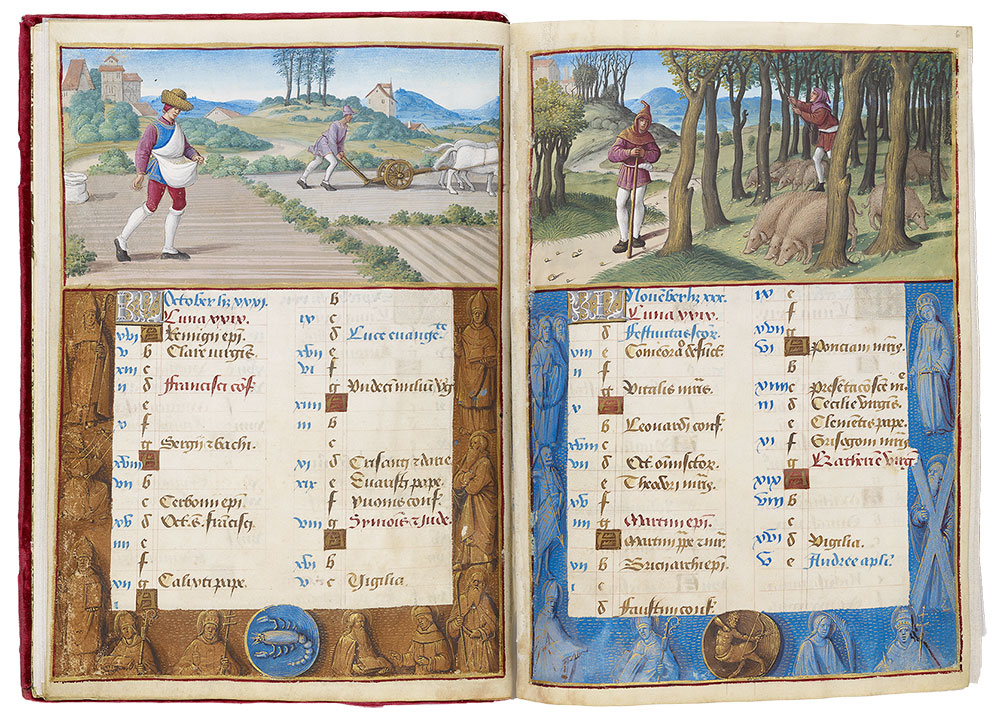
October: Sowing and Ploughing
November: Thrashing for Acorns
Hours of Henry VIII
Illuminated by Jean Poyer
Gift of the Heineman Foundation, 1977
October: Sowing and Ploughing (fol. 5v)
In October the winter wheat is sown. The man at left sows the field with grain he holds in his apron. The man on the right plows his field with a team of white horses.
Beneath St. Remigius (October 1) in the left margin is St. Francis, receiving the stigmata (October 4). They are followed by two bishop saints, one of whom is undoubtedly Cerbonius (October 10), and, finally, Pope Calixtus (October 14). The zodiacal sign is Scorpio, the Scorpion.
November: Thrashing for Acorns (fol. 6)
In November the labor is to take the pigs to the forest and rattle the branches of the oak trees so they shed their acorns, thus fattening up the animals.
In the left margin are a large group of saints (for the Feast of All Saints, November 1), Death as a skeleton (for the feast of All Souls, November 2), and Sts. Martin (bishop of Tours, November 11) and Brictius (archbishop of Tours, November 13).
At the right are Sts. Catherine, with a palm of martyrdom and the sword of her decapitation (November 25), Andrew the Apostle, holding his X-shaped cross (November 30), Clement, in papal tiara (November 23), and Cecilia (November 22). The zodiacal sign is Sagittarius, the Archer.